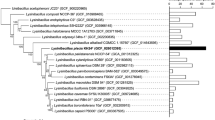Abstract
A real-time PCR assay for the detection of species from the genera Azadinium and Amphidoma (family Amphidomataceae) was developed in order to screen field samples and to aid in the isolation of azaspiracid (AZA)-producing dinoflagellates. The assay was highly specific and sensitive and allowed the rapid detection of target species. Samples collected as part of the New Zealand Marine Phytoplankton Monitoring Programme were analysed using the Amphidomataceae real-time PCR assay. Azadinium poporum was detected in New Zealand for the first time, and a culture was successfully established. Extracts of this isolate proved to be of low toxicity to mice and did not contain AZA-1, -2 or -3. Field samples will continue to be screened with the aim of identifying AZA-producing species. The Amphidomataceae real-time PCR assay will be a useful tool for monitoring programmes and taxonomic surveys worldwide.



Similar content being viewed by others
References
Drummond AJ, Ashton B, Buxton S, Cheung M, Cooper A, Duran C, Field M, Heled J, Kearse M, Markowitz S, Moir R, Stones-Havas S, Sturrock S, Thierer T, Wilson A (2011) Geneious v5.4, Available from www.geneious.com
Gu H, Luo Z, Krock B, Witt M, Tillmann U (2013) Morphology, phylogeny and azaspiracid profile of Azadinium poporum (Dinophyceae) from the China Sea. Harmful Algae 21–22:64–75
Guillard RRL, Ryther JH (1962) Studies of marine planktonic diatoms: I. Cyclotella nana Hustedt, and Detonula confervacea (Cleve) Gran. Can J Microbiol 8:229–239
Huelsenbeck JP, Ronquist F (2001) MRBAYES: bayesian inference of phylogenetic trees. Bioinformatics 17:754–755
James KJ, Fidalgo Sáez MJ, Furey A, Lehane M (2004) Azaspiracid poisoning, the food-borne illness associated with shellfish consumption. Food Addit Contam 21:879–892
Krock B, Tillmann U, John U, Cembella AD (2009) Characterization of azaspiracids in plankton size-fractions and isolation of an azaspiracid-producing dinoflagellate from the North Sea. Harmful Algae 8:254–263
Krock B, Tillmann U, Voß D, Koch BP, Salas R, Witt M, Potvin É, Jeong HJ (2012) New azaspiracids in Amphidomataceae (Dinophyceae). Toxicon 60:830–839
Krock B, Tillmann U, Witt M, Gu H (2014) Azaspiracid variability of Azadinium poporum (Dinophyceae) from the China Sea. Harmful Algae 36:22–28
Munday R (2014) Toxicology of seafood toxins: a critical review. In: Botana L (ed) Seafood and freshwater toxins, pharmacology, physiology, and detection, 3rd edn. CRC Press, NY, pp 197–290
Nunn GB, Theisen BF, Christensen B, Arctander P (1996) Simplicity-correlated size growth of the nuclear 28S ribosomal RNA D3 expansion segment in the crustacean order Isopoda. J Mol Evol 42:211–223
Percopo I, Siano R, Rossi R, Soprano V, Sarno D, Zingone A (2013) A new potentially toxic Azadinium species (Dinophyceae) from the Mediterranean Sea, A. dexteroporum sp. nov. J Phycol 49:950–966
Rhodes L, Harwood T, Smith KF, Argyle P, Munday R (2014) Production of ciguatoxin and maitotoxin by strains of Gambierdiscus australis, G. pacificus and G. polynesiensis (Dinophyceae) isolated from Rarotonga, Cook Islands. Harmful Algae 39:185–190
Salas R, Tillmann U, John U, Kilcoyne J, Burson A, Cantwell C, Hess P, Jauffrais T, Silke J (2011) The role of Azadinium spinosum (Dinophyceae) in the production of azaspiracid shellfish poisoning in mussels. Harmful Algae 10:774–783
Satake M, Ofuji K, James K, Fury A, Yasumoto T (1998) New toxic events caused by toxic mussels. In: Reguera B, Blanco J, Fernandez ML, Wyatt T (eds) Harmful Algae. Xunta de Galicia and International Oceanographic Commission of UNESCO, Santiago de Compostela, pp 468–469
Scholin CA, Herzog M, Sogin M, Anderson DM (1994) Identification of group-specific and strain-specific genetic-markers for globally distributed Alexandrium (Dinophyceae). II. Sequence analysis of a fragment of the LSU rRNA gene. J Phycol 30:999–1011
Thompson JD, Higgins DG, Gibson TJ (1994) CLUSTAL W: improving the sensitivity of progressive multiple sequence alignment through sequence weighting, position-specific gap penalties and weight matrix choice. Nucleic Acids Res 22:4673–4680
Tillmann U, Elbrachter M, Krock B, John U, Cembella A (2009) Azadinium spinosum gen. et sp nov (Dinophyceae) identified as a primary producer of azaspiracid toxins. Eur J Phycol 44:63–79
Tillmann U, Elbrächter M, John U, Krock B (2011) A new non-toxic species in the dinoflagellate genus Azadinium: A. poporum sp. nov. Eur J Phycol 46:74–87
Tillmann U, Salas R, Jauffrais T, Hess P, Silke J (2014) AZA: the producing organisms - biology and trophic transfer. In: Botana LM (ed) Seafood and freshwater toxins. CRC Press, Boca Raton, pp 773–798
Toebe K, Joshi AR, Messtorff P, Tillmann U, Cembella A, John U (2013) Molecular discrimination of taxa within the dinoflagellate genus Azadinium, the source of azaspiracid toxins. J Plankton Res 35:225–230
Twiner M, Rehmann N, Hess P, Doucette G (2008) Azaspiracid shellfish poisoning: a review on the chemistry, ecology, and toxicology with an emphasis on human health impacts. Mar Drugs 6:39–72
Acknowledgments
Thanks to the Cawthron Institute Biotoxin and Microalgae Laboratories for azaspiracid analyses and Azadinium notifications, respectively, and Dr. Haifeng Gu (Third Institute of Oceanography, China) for kindly providing the Azadinium poporum culture (strain AZDY06). Thanks also to MSQP for allowing the use of commercial samples for research purposes. This study was funded by the New Zealand Ministry for Business, Innovation and Employment (Safe New Zaland Seafood contract no. CAWX1317).
Author information
Authors and Affiliations
Corresponding author
Rights and permissions
About this article
Cite this article
Smith, K.F., Rhodes, L., Harwood, D.T. et al. Detection of Azadinium poporum in New Zealand: the use of molecular tools to assist with species isolations. J Appl Phycol 28, 1125–1132 (2016). https://doi.org/10.1007/s10811-015-0667-5
Received:
Revised:
Accepted:
Published:
Issue Date:
DOI: https://doi.org/10.1007/s10811-015-0667-5




